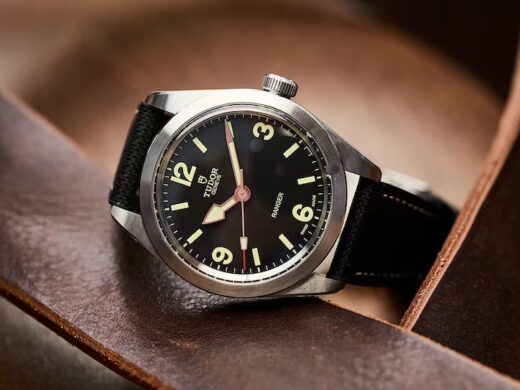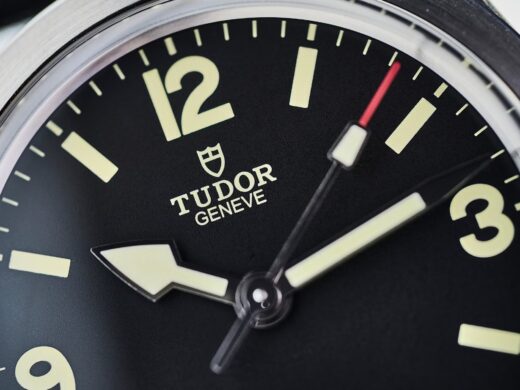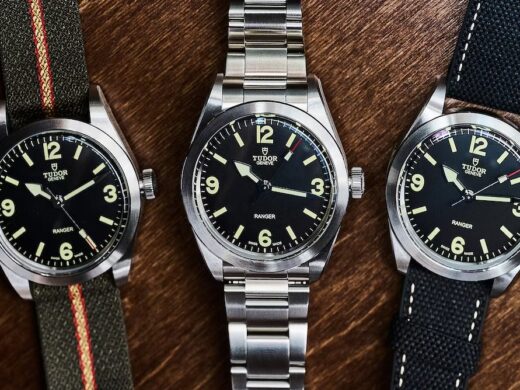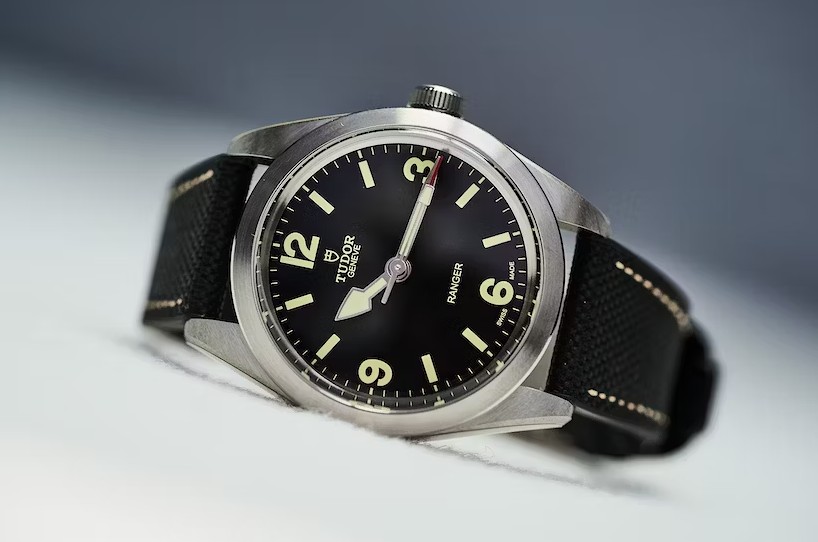Tudor possesses a remarkable talent for precision. An exemplary demonstration of this can be seen in the 39mm Tudor Ranger timepiece. At first glance, its simplicity is apparent, but upon closer inspection, a fascinating complexity emerges. Today, we embark on an in-depth exploration of this remarkable watch.
The 39mm Tudor Ranger’s case design is quite similar to that of the Black Bay 58, following a familiar pattern. The absence of crown guards allows the crown to stand alone, while the lugs gently curve towards the edges, giving the watch an elegant appearance. Along the bezel’s edge and lug facets, there is a subtle touch of polish, while the case sides are mostly brushed. Whenever I gaze upon the construction of the 39mm Tudor Ranger’s case, I can’t help but be reminded of the architectural style known as Brutalism.

Just like the buildings fashioned in this distinctive style, the Ranger’s case exudes a sense of seriousness and practicality. The brushed finish accentuates the focus on the case structure, drawing attention to its rugged elegance. In stark contrast, the Rolex Explorer 14270 presents a different aesthetic. Not only is its case significantly smaller at 36mm, but it also boasts curvier case sides complemented by a polished finish on both the sides and bezel, lending it a more refined and multi-dimensional appearance.
The vintage allure of earlier models is preserved in the 39mm Tudor Ranger through its dial. A faded black shade gives the impression that the watch has weathered the elements of outdoor life. Enhancing its quaint aesthetic, the dial boasts a subtle grainy texture. Continuing the patinated theme, the markers and numerals exhibit a charming yellow-green hue.
The typeface chosen for the numerals evokes an old-world feel, reminiscent of the Explorer 1016. However, upon closer examination, one can observe slight variations in the presentation of the numerals as a whole, particularly noticeable in the six and nine. The numeral six forms a horizontal oval as its loop intertwines with itself, displaying an exaggerated swoop above. Similarly, the nine numerals present an inverted variation of this characteristic. Initially, I speculated that these variations might be a result of the crystal distorting the numbers due to bowing. Yet, it turns out that this distinct presentation is intentional, evoking a reminiscent vibe of mid-century divers that embraced unconventional cardinal numerals, much like the Oris Diver 65.

The 39mm and 41mm versions of the Ranger exhibit notable distinctions. In the current 39mm model, the numerals and markers are pad printed onto the dial, providing a balanced and well-proportioned appearance. On the other hand, the 41mm Ranger features raised markers and numerals, which add depth but tend to be overshadowed by the larger dial. In terms of the hour hand, the 39mm Ranger stands out with its unique “Ranger” or “snakehead” design. Unlike the Mercedes hand found on other models like the Explorer, the Ranger’s hour hand is exclusive to the Ranger itself. Moreover, the 39mm version showcases a slightly smaller handset, contributing to the dial’s proportional aesthetics. The second hand maintains its syringe style, with only the “needle” part featuring a red accent. Unlike the text-heavy dials of some Tudor watches, the 39mm Tudor Ranger adopts a minimal and straightforward approach in its dial presentation, embodying the philosophy of “less is more.”
Tudor possesses remarkable expertise in crafting robust stainless steel bracelets, and their proficiency shines through in the Ranger model. The bracelet showcases a skillful taper, seamlessly transitioning from the endlinks to the clasp, which impeccably complements the updated case and dial. Moreover, the inclusion of the T-Fit clasp adjusting system, initially introduced in the Black Bay 58 Bronze, adds a sleek touch. Interestingly, this feature distinguishes the Ranger’s bracelet from that of the 41mm Ranger or any Rolex Explorer.
The 39mm Tudor Ranger and the Rolex Explorer 14270 are distinct timepieces. Nevertheless, these watches share more similarities than we might anticipate. Naturally, they share a common aesthetic and originate from the same brand lineage. However, when we delve deeper into the essence and genesis of these timepieces, their narratives align remarkably—before the Explorer existed, the Oyster Perpetual triumphed atop Mount Everest, while the Oyster Prince accompanied the renowned British North Greenland Expedition even before the Ranger came into existence.

Both watches possess distinctive characteristics that set them apart. The 39mm Tudor Ranger exhibits a cohesive blend of features and design choices. As a straightforward time-only sports watch, it exudes a sense of understated elegance, reminiscent of the enigmatic Jason Bourne. The Ranger’s brushed case, flat markers, and minimal dial text contribute to its discreet demeanor. It is apparent that Tudor aimed to create a timepiece that seamlessly adapts to any situation, akin to the versatile Rolex Explorer. However, the Explorer adds a touch of panache and luxury to its everyday functionality. Whether in the field or complementing a tuxedo, the Explorer, like James Bond, effortlessly fits in. On the other hand, the Tudor Ranger caters more to casual occasions that don’t necessitate a bow tie and a suave jacket.
The Tudor Ranger, available on a bracelet, presents an appealing price point of $3,150. It offers an abundance of features that make it a noteworthy timepiece, including excellent brand quality, a rich model heritage, a T-Fit equipped steel bracelet, and an in-house movement with an impressive 70-hour power reserve. Additionally, it incorporates a silicon balance spring and holds a COSC certification, ensuring reliable timekeeping.
I personally believe that a slightly smaller case size, reminiscent of the original Ranger, would be a welcome addition. Let’s envision it at around 36mm to 37mm, and for added excitement, let’s include a date function with a cyclops magnifier. I must confess my genuine interest in owning a 36mm Ranger with a cyclops date. In fact, I would seriously consider placing it alongside my Explorer 14270 in my watch box. As for the 39mm Tudor Ranger, along with its 39mm steel sports counterparts, I believe it will remain a staple in Tudor’s collection for the foreseeable future.


No comments yet.